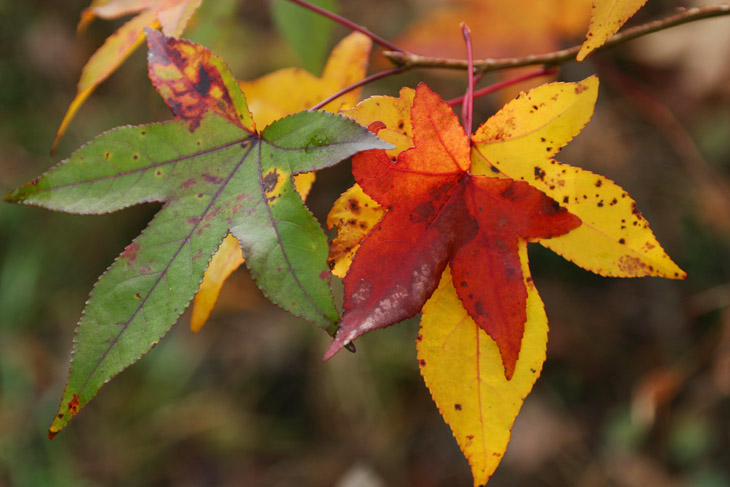
Okay, don’t do that. All I was referring to was actually getting out to do a bit of shooting (like, over 400 frames) when I’ve been doing almost nothing for the past few weeks. Both students that I had to cancel out on last weekend when I felt like crud had been rescheduled for this weekend, when we had some surprisingly cooperative weather, so I was able to chase some more things of interest.
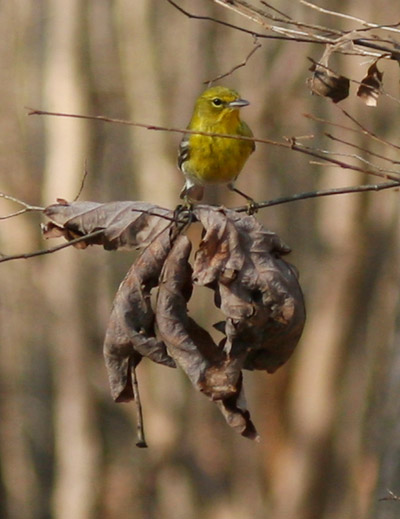 Curiously, the conditions were radically different within a small geographic area. Mason Farm Biological Reserve was largely as expected for this time of year: loaded with grey and brown dried foliage, with the only activity coming from the birds (well, and the birders and joggers.) As seen above, some splashes of color could be found if one was selective, but most of it looked like the image at left, far too close to monochrome. This, by the way, is a tight crop from the original frame, since I hadn’t bothered with the weight of the long lens (again, I was with a student) and so wasn’t loaded for birds, but this female American goldfinch (Spinus tristis) was kind enough to forage through a clump of leaves only a handful of meters away and was captured with the Mamiya 80mm macro. It was alone among the many birds seen yesterday, since it not only remained relatively close, but even chose good light conditions – far too many of them either remained on the shady sides of the trees or only popped out momentarily while at too great a distance. Had we picked a spot and exercised a lot of patience, however, we might have had a bit more luck.
Curiously, the conditions were radically different within a small geographic area. Mason Farm Biological Reserve was largely as expected for this time of year: loaded with grey and brown dried foliage, with the only activity coming from the birds (well, and the birders and joggers.) As seen above, some splashes of color could be found if one was selective, but most of it looked like the image at left, far too close to monochrome. This, by the way, is a tight crop from the original frame, since I hadn’t bothered with the weight of the long lens (again, I was with a student) and so wasn’t loaded for birds, but this female American goldfinch (Spinus tristis) was kind enough to forage through a clump of leaves only a handful of meters away and was captured with the Mamiya 80mm macro. It was alone among the many birds seen yesterday, since it not only remained relatively close, but even chose good light conditions – far too many of them either remained on the shady sides of the trees or only popped out momentarily while at too great a distance. Had we picked a spot and exercised a lot of patience, however, we might have had a bit more luck.
Below, some tenacious leaves on a vine capture the morning sun from behind and stand out from the landscape rather distinctly. I’m embarrassed by this now, because I’m sure they were just trying to attract attention, and I don’t like encouraging such wanton behavior.
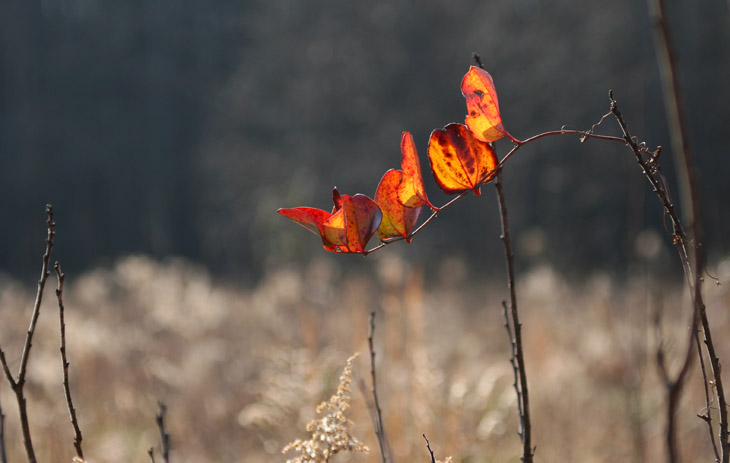
Having exhausted what Mason Farm had to offer, we hiked the short separation over to the North Carolina Botanical Garden, which presented a lot more of interest even as we first hit the entrance. Several species of flowers were still in bloom, and the warmth of the day had brought the pollinators back out, some still appearing to be groggy from the overnight chill.
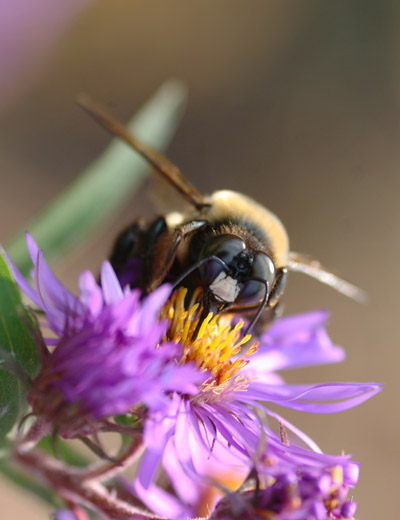 The clusters of late-blooming flowers were a drastic difference from the nearby reserve, and the bees were making the most of it before another drop in temperature sent them back to the protection of their hives and nests. This one is most likely a male Eastern carpenter bee (Xylocopa virginica,) betrayed by the white spot on its face. I’m among the many who consider everything that looks like this a “bumblebee,” but technically it’s not. Supposedly, it also lacks a stinger, and maybe some day I’ll test out this hypothesis by snagging one as it raids a blossom – anything for science.
The clusters of late-blooming flowers were a drastic difference from the nearby reserve, and the bees were making the most of it before another drop in temperature sent them back to the protection of their hives and nests. This one is most likely a male Eastern carpenter bee (Xylocopa virginica,) betrayed by the white spot on its face. I’m among the many who consider everything that looks like this a “bumblebee,” but technically it’s not. Supposedly, it also lacks a stinger, and maybe some day I’ll test out this hypothesis by snagging one as it raids a blossom – anything for science.
The activity seemed to be evenly split between the carpenter bees and the European honeybees (Apis mellifera,) with a single hoverfly making an appearance but not holding still long enough for me to lock focus – actually, it seemed to be chasing me off as I loomed in, very distinctly concentrating on the lens rather than the flower every time I was close enough for a shot. But the honeybees were more cooperative.

I just spent far too long trying to determine what these flowers were, with no luck at all – in my defense, they were in a patch with no ID markers. You’d think it wouldn’t be that hard to find something that blooms in December, but maybe my Google-Fu is rusty…
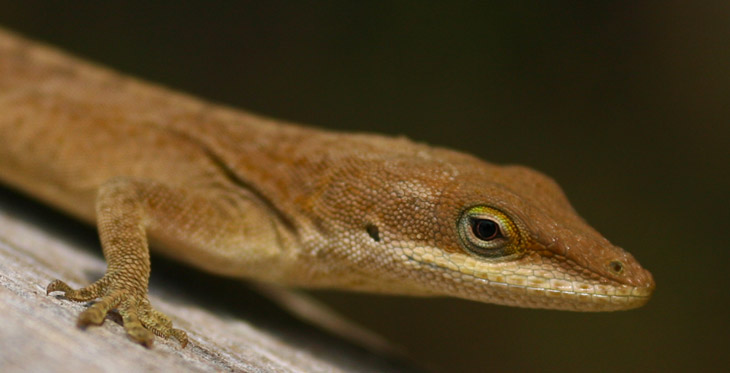
Another surprise was a green anole, here displaying a brownish hue, that was dodging us on a trellis before we finally caught it during a pause. I always like the anoles; there’s something about their mosaic skin. Note the short depth that shows the full face, but then nothing else in sharp focus but the foot. Capturing these images in the garden made me feel I had accomplished something for the day.
You may recall that I pointed out an astronomical event a short time back, the occultation of Venus. As it always goes, the skies went completely sour around here after I mentioned it on the blog, or perhaps almost completely – after writing it off and getting involved in other things, the skies cleared abruptly and might even have permitted a view of the emergence from behind the moon. Anyway, in superstitious recognition of repeated posts about upcoming events that produced nothing of any kind to follow-up with, I kept mum about the Geminids meteor shower, which peak tonight and tomorrow night but had already shown significant activity on earlier evenings, at least according to some observers. So last night I went out, with nice clear skies, and tried my luck.

I was getting halfway decent views and exposures, but not a meteor to be seen. And yes, I know this isn’t Gemini, which sits above and to the left of Orion, but Orion was more interesting. Doesn’t matter – not one exposure showed a damn thing, nor did I see anything outside of the camera’s field of view. So as the clouds started obscuring the stars, I switched subjects and did a quick experiment, which due to the conflicting light colors, looks much better in monochrome.
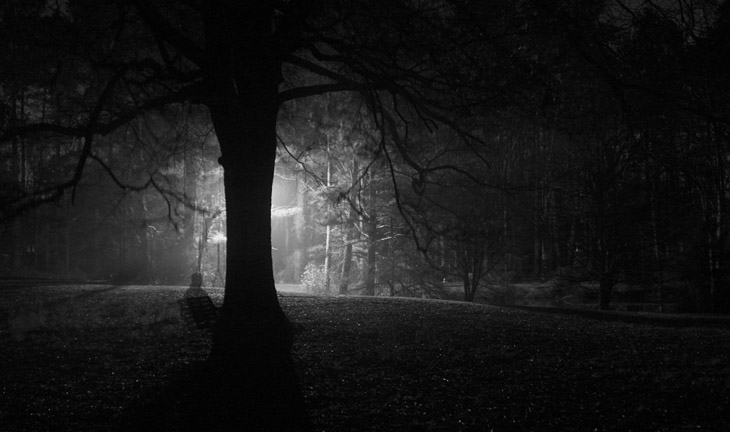
Yes, that’s me; twenty-second exposure, where I took my place for about fifteen of it, light produced by a streetlamp behind the tree. I’ve tried this before, but this one finally came out about how I’d intended, so I have at least that to show for the night’s session.




















































